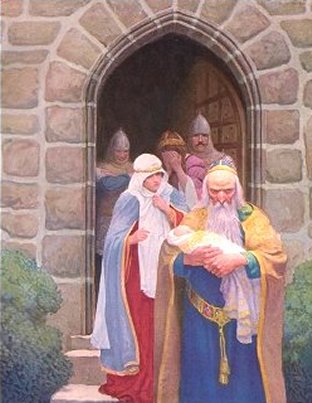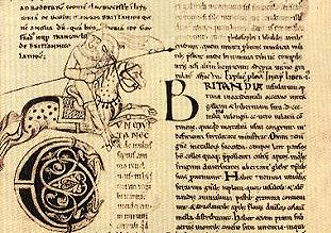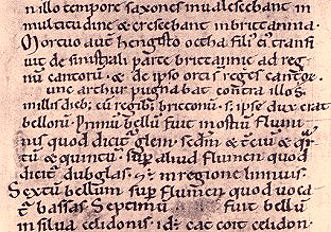Page 2 of 4
Avalon in the New World
Merlin and the Discovery of

Vivien and Merlin by the nineteenth-century French artist Gustave Doré. In legend Merlin was a wizard, King Arthur's mentor, and the guardian of the Holy Grail. Could the myth have been based on an historical figure?
During the Middle Ages the story of Merlin was popularized in the so-called Arthurian Romances, romantic tales first written in the twelfth and thirteenth centuries. These stories were set many years earlier, in the fifth century, when Britain was in turmoil after the end of Roman rule. Historically, following the collapse of the Roman Empire, Britain declined into anarchy; native warlords fought each other and, to make matters worse, the Anglo-Saxons from Denmark and Germany began to invade. According to the Arthurian Romances, it was Merlin who saved the Britons from this chaos. In these tales the wise wizard cleverly contrives to make Arthur Britain's sole king, thus unifying the country against the invaders. Although there is peace for a while, the Britons are eventually drawn into civil war when Arthur falls sick and his knights argue amongst themselves. To reunite the country, Merlin devises a quest. He is guardian of the Holy Grail, a sacred cup that when drunk from can cure all ills. However, rather than simply let Arthur drink from the vessel, Merlin sends the knights in search of its secret hiding place, knowing that in their searching they will acquire the wisdom to again work as one. It is Sir Perceval who eventually finds the Grail; Arthur recovers, and the land is reunited. Merlin then retires to the mysterious Grail Castle where the relic is kept, appoints Perceval as the Grail's new guardian, and ultimately sails off to the secret isle of Avalon.

The Merlin Legend
According to the Arthurian legend Merlin took Arthur when he was still a baby and secretly raised him to become Britain's unifying king.
The Two Dragons


Pages from Geoffrey of Monmouth's History of the British Kings (left) and Nennius' History of the Britons. Taken together, passages from these works reveal the man behind the Merlin myth.
From the time the Roman Empire collapsed in the fifth century, until the Norman Conquest of 1066, civilization fell apart in Britain, and the country endured an era of chaos and warfare known as the Dark Ages. Few written records have survived from this time; consequently, the fifth century, when Arthur and Merlin are said to have lived, is an historical period steeped in mystery. The records that do survive only provide a rough outline of events, and most contemporary figures went completely unrecorded. Although, like Arthur, Merlin is mentioned in a few surviving Dark Age manuscripts, he is only referenced in passing. The first author to provide any actual detail concerning Merlin's life was the Welsh cleric Geoffrey of Monmouth who wrote in the 1130s. In his History of the British Kings Geoffrey introduces Merlin by saying that he first proved himself as a youth when a British king named Vortigern chose him as a sacrifice. According to Geoffrey, Vortigern was building a fort on a mountain in North Wales to protect his kingdom from the invading Anglo-Saxons, but each time the fort was close to completion the foundations mysteriously collapsed. Vortigern's advisors suggest that to put things right a boy must be sacrificed, and victim they pick is the young Merlin. However, just as Merlin is about to die, he tells the king that the problems are being caused by two dragons that dwell in a pool, in a cave below the fort's foundations. When the pool is discovered and the dragons released, Vortigern is so impressed by Merlin's mystic knowledge that he makes him his chief advisor and offers him the new fort as his own. Although this story is obviously an imaginative legend, a Dark Age manuscript records a similar story which reveals an historical figure behind the Merlin myth.
Vortigern was certainly an historical figure: he is recorded by Dark Age writers as the ruler of much of Britain in the mid-fifth century. Around the year 830 one Dark Age chronicler refers to King Vortigern when recounting a similar legend to Geoffrey's story of Merlin and the two dragons. In his History of the Britons the British monk Nennius wrote about a young man who saved himself being sacrificed by Vortigern by revealing that two dragons dwelt in a cave below the king's fort. The story is almost word-for-word that told by Geoffrey; the only difference is that the youth is not called Merlin, but Ambrosius. As both accounts are virtually identical, could this Ambrosius have been the man upon whom the stories of Merlin were based?
Left: Medieval depiction of the story of Merlin and the two dragons related by Geoffrey of Monmouth.

Although the Arthurian Romances were obviously embellished with fanciful detail, there is compelling evidence to show that, in essence, the story of Merlin was based on the life of an historical figure.








